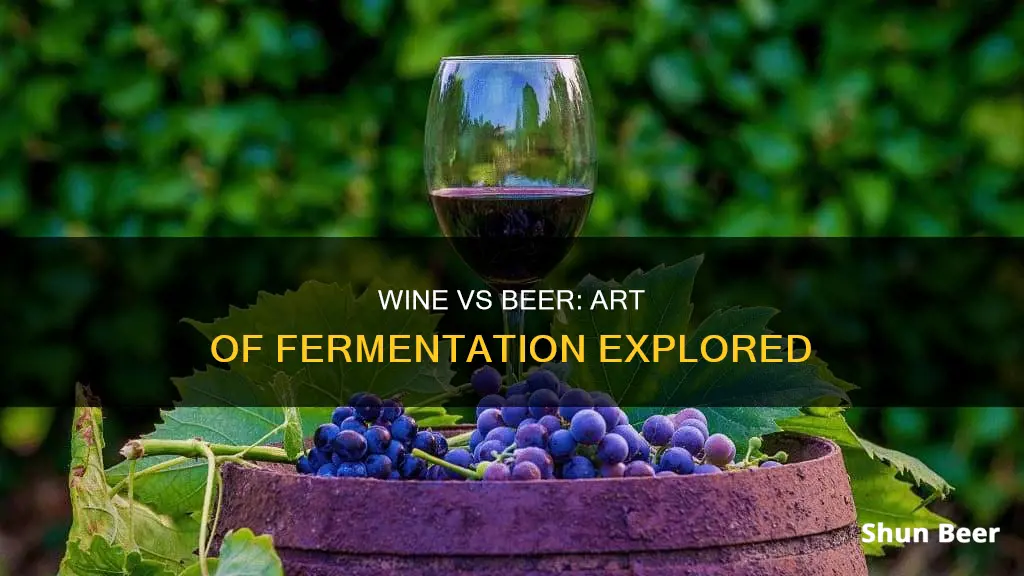
The processes of winemaking and beer brewing share some similarities, but also exhibit key differences. Both alcoholic beverages rely on the fermentation of sugars present in their base ingredients—grapes and grains, respectively—to produce alcohol. However, the distinct raw materials and production processes of wine and beer result in two very different drinks.
What You'll Learn
- Wine ferments naturally, but beer requires cooking to convert starches into sugars
- Wine is made from fruit, whereas beer is made from grains
- Wine is typically stored in oak barrels, while beer is stored in metal barrels
- Wine requires sulphur dioxide to prevent unwanted bacteria from contaminating the liquid
- Wine takes longer to prepare than beer

Wine ferments naturally, but beer requires cooking to convert starches into sugars
Wine and beer are two very different drinks, and their production processes reflect this. While both wine and beer require fermentation, the processes by which they are made differ significantly.
Wine ferments naturally, as the fruit used is filled with sugar and will naturally ferment when exposed to the ambient yeasts in the air. Crushed grapes will ferment on their own, and this is how many anthropologists believe wine was first discovered in ancient times. Other fruits used in wines, such as apples, pears, and berries, undergo the same process, which is mostly crushing and waiting.
Beer, on the other hand, requires cooking to convert starches into sugars. Beer begins as grain, which does not contain sugar. Brewers must create a mash by mixing the grains with hot water to expose an optimal amount of starchy surface area. Over a few hours, the ground grain releases its sugars into the liquid, creating a sugary substance known as "wort". The grains are then separated from the wort, which ferments into beer.
The processes of winemaking and beer-making are distinct, and the ingredients used are very different. Wine is made from fruit, whereas beer is made from grains. Wine is not carbonated, while beer can be.
Beers Around the World: A Guide to Varieties
You may want to see also

Wine is made from fruit, whereas beer is made from grains
Wine and beer are two distinct alcoholic beverages that differ in terms of their raw materials, production processes, flavours, and even social perceptions. One of the fundamental differences lies in their primary ingredients: wine is made from fruit, while beer is made from grains.
Wine, as an alcoholic beverage, owes its existence to the fermentation of fruit juices, most commonly grapes. In fact, in the European Union, wine is legally defined as the fermented juice of grapes. However, wine can also be made from other fruits, including apples, cranberries, pomegranates, and plums. During the wine-making process, the fruit skin and meat are squeezed to release the pigment and extract the juice. This juice then undergoes fermentation, where the natural sugars in the fruit are converted into alcohol and carbon dioxide by yeast. The sugar quantity decreases, while the alcohol volume increases. To maintain the fruitiness and freshness of the wine, winemakers often add sulfur dioxide immediately after fermentation. The wine is then stored, and the time it spends ageing contributes to its flavour and quality. The longer it ages, the better it tends to taste.
On the other hand, beer has its origins in grains, with malted barley being the most common grain used in brewing. Other grains such as corn, rice, and wheat are also used in beer-making. Unlike fruit, which naturally contains sugars, grains are primarily composed of carbohydrates. Therefore, brewing beer involves transforming these carbohydrates into sugars through a process called mashing. Brewers mix the grains with hot water to create a mash, from which they can extract fermentable sugars. This mixture is then separated, leaving a sugary liquid called wort. The wort is then boiled and hops are added, giving the beer its distinct flavour. After cooling, yeast is introduced to initiate fermentation, converting the sugars into alcohol.
The difference in raw materials, fruits versus grains, leads to variations in the production processes and flavours of wine and beer. Fruits used for wine typically contain readily available sugars that can be quickly fermented, whereas grains used for beer require additional processing to convert their starches into sugars. This fundamental distinction shapes the unique characteristics of each beverage.
Additionally, the social perceptions of wine and beer often differ. Wine is sometimes associated with class and elegance, while beer is seen as a more casual, accessible drink for the general public. However, these perceptions are not absolute, and both beverages can appeal to diverse audiences.
Beers vs Lagers: What's the Difference?
You may want to see also

Wine is typically stored in oak barrels, while beer is stored in metal barrels
Wine and beer have distinct production processes, and the vessels used for their storage differ too. Wine is typically stored in oak barrels, while beer is stored in metal barrels.
The use of oak barrels for wine storage and ageing is steeped in history. Over two millennia ago, the Romans, while spreading their empire, wanted to take wine with them on their journeys. Initially, clay amphorae were used to transport wine, but as the Romans pushed north into Europe, wooden barrels, often made of oak, were adopted from the Gauls. Oak was favoured because it was abundant in continental Europe, easy to bend into the traditional barrel shape, and offered a waterproof storage medium.
Over time, it was discovered that contact with oak improved the wine's qualities. Oak softens and smooths wine, and can enhance its taste. Oak barrels impart flavour compounds to the wine, adding aromas of vanilla, clove, smoke, and coconut. The slow ingress of oxygen through the oak barrels also makes the wine taste smoother and less astringent.
Today, oak barrels remain an integral part of modern winemaking. The type of oak and its origin can influence the flavours imparted to the wine. For example, wines aged in Quercus petrea oak from Allier, France, will have distinct flavours compared to wines aged in Quercus petrea oak from the Zemplen Mountains in Hungary.
On the other hand, beer is often stored in metal barrels. While wooden barrels were once commonly used for beer storage, sanitation issues and the susceptibility of beer to bacterial infections have led to a shift towards metal barrels. Metal barrels help prevent spoilage organisms and bacterial growth, ensuring the beer remains fresh and safe for consumption.
However, some brewers still use wooden barrels, particularly oak barrels, to age beer and impart unique flavours. Bourbon barrels, for instance, can add vanilla, tannin, and burnt wood flavours to the beer, along with residual whiskey notes. Wine barrels, with their various types of wood, can also contribute distinct flavours to the beer.
Amber vs Lager: Unveiling Beer's Colorful Secrets
You may want to see also

Wine requires sulphur dioxide to prevent unwanted bacteria from contaminating the liquid
Wine and beer are two distinct alcoholic beverages with different production processes and ingredients. While both wine and beer production involves fermentation, wine is made from grapes, whereas beer is made from grains.
Sulphur Dioxide in Winemaking
Sulphur dioxide (SO2) is introduced into wine immediately after the fermentation process. This treatment serves as a preservative, acting as a barrier against oxidation and unwanted bacteria. It helps to maintain the fruitiness and freshness of the wine, preventing unwanted bacteria from contaminating the liquid.
SO2 is highly reactive due to its six valence electrons, enabling it to chemically bond with other compounds in various ways, contributing to the formation of a diverse range of molecules. This reactivity results in a wide range of effects on the wine's chemistry, influencing its aromas, mouthfeel, structure, and development during vinification.
The use of SO2 in winemaking has been a subject of debate, with some winemakers aiming to reduce or eliminate its use. While it is effective in preventing oxidation and bacterial contamination, some believe it mutes the delicate nuances that express vintage or vineyard character. Additionally, the presence of SO2 can affect the formation and prevalence of other compounds in wine, such as aldehydes, amino acids, peptides, and fusel alcohols.
Beer Making
In contrast, beer-making starts with grains, such as malted barley, corn, rice, or wheat, which are crushed and mixed with hot water to create a mash. This process breaks down the carbohydrates in the grains into sugars, which then ferment into alcohol.
In summary, while both wine and beer involve fermentation, the key difference lies in their starting ingredients and the subsequent production processes. Wine is made from grapes and requires sulphur dioxide to prevent contamination, while beer is made from grains and undergoes a mashing process to convert carbohydrates into sugars.
Explore the Differences: Ale, Bitter, and Beer
You may want to see also

Wine takes longer to prepare than beer
Wine and beer are both alcoholic beverages that have been consumed for thousands of years. Despite sharing some similarities in their production processes, there are significant differences between winemaking and beer brewing, particularly in terms of preparation time. Indeed, wine takes longer to prepare than beer.
The main difference in the production time lies in the distinct raw materials used for each beverage. Beer is primarily made from grains, such as malted barley, corn, rice, or wheat, while wine is produced from fruit, typically grapes. The preparation time is influenced by the characteristics of these raw materials and the subsequent processing methods.
For beer, the grains are harvested and soaked to release sugars. This process involves milling the grains to expose a sufficient surface area, followed by a cooking process to convert the starches into sugars that yeast can consume. The cooked grain mixture, known as wort, is then boiled to neutralise any unwanted bacteria and ensure a consistent flavour profile. After this process, the wort is moved to a brewing kettle, where hops are added, and the mixture is boiled for a couple of hours.
On the other hand, winemaking involves crushing and pressing grapes to extract their juice. This process used to be done by trampling the grapes with bare feet, but modern technology has made it easier and faster with specialised machines. The skins of the grapes may be peeled or left intact, depending on whether the goal is to make white or red wine, respectively.
After the initial extraction processes for both beverages, the fermentation begins. During fermentation, yeast is added to convert the sugars present in the grape juice or wort into alcohol and carbon dioxide. However, the fermentation process takes longer for wine than for beer due to the different raw materials and desired outcomes.
For beer, the fermentation process can be completed within a couple of weeks, after which the beer can be bottled or stored in barrels. In contrast, wine requires a minimum of two months and often a year or more before it is ready for consumption. The longer ageing period for wine enhances its flavour, and the longer it ages, the better it tastes. This ageing period is a significant contributor to the overall preparation time for wine.
Ginger Ale vs Ginger Beer: What's the Difference?
You may want to see also
Frequently asked questions
The main difference is in the ingredients used. Winemaking uses fruit, whereas beer making uses grains.
Yes, they do. With winemaking, the fruit is crushed and pressed to extract the juice. For beer making, the grains are milled and cooked to convert the starches into sugars.
Wines can take a minimum of two months or even a year or more before they are ready to drink. Beers, on the other hand, can be bottled and safely consumed after at least two weeks of storage.







